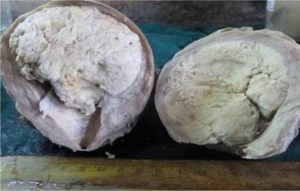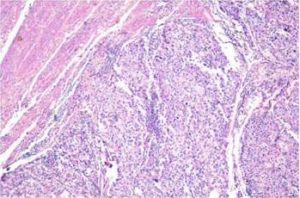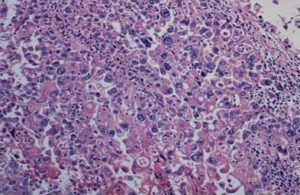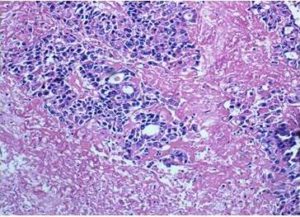Introduction
Uterine Leiomyosarcomas are rare tumors which comprise approximately 1% of the female genital tract malignancies and 3%-7% of uterine malignancies according to the study by Major et al. (1993). Uterine sarcomas include leiomyosarcomas, endometrial stromal sarcomas, adenosarcomas, undifferentiated endometrial sarcomas, and their variants. Leiomyosarcomas account for about 40% of uterine sarcomas. The current WHO criteria for the diagnosis of leiomyosarcomas NOS require assessment of any coagulative tumor cell necrosis. In the absence of tumor cell necrosis, the diagnosis requires diffuse, moderate to severe cytological atypia and a mitotic index of more than or equal to 10mf/10hpf. A variety of exogenous and endogenous hormones can influence the mitotic index and the development of tumor cell necrosis.
Epithelioid variant of Leiomyosarcoma, though rare, is an important subtype, since it bears distinct morphological and immunohistochemical patterns which are different from the conventional type. At the same time, it needs to be differentiated from the uterine epithelial malignancies since they share similar morphological and immunohistochemical features but have different behavioural patterns. Abeler et al. (2009) mentioned that leiomyosarcomas are more aggressive than any other epithelial or mesenchymal malignancy of the uterus, with their frequent local recurrence and distant metastasis, and hence should never be misinterpreted or missed at any cost.
An interesting occurrence of a Uterine Epithelioid Leiomyosarcoma (LMS) in a leiomyoma in a postmenopausal woman is reported here considering its rarity and the relatively more aggressive nature of the tumor as compared to all the other uterine malignancies, the frequency of local recurrence and the distant metastasis, all of which make it an important entity.
Case Report
A seventy eight-year old lady who attained menopause twenty years earlier presented with complaints of mass per vagina of a five-year duration associated with bleeding per vagina and mucoid, foul-smelling whitish discharge since two years.
General examination revealed no significant findings except pallor.
Per speculum examination showed a third degree utero-vaginal descent associated with keratinisation of the posterior lip of cervix.
On per-vaginal examination, a mass was felt in the pouch of Douglas.
Abdomino-Pelvic Ultrasonography revealed a large echogenic intra -mural mass measuring 12x10x9cm, in association with another small, echogenic mass arising from the outer surface of the uterus.
Clinico-Radiological Diagnosis – Large Uterine Intramural Fibroid in Association with a Subserosal Fibroid
The patient underwent trans-abdominal total hysterectomy with bilateral salpingo-oophorectomy and pelvic floor repair. The specimen was submitted for histopathological examination.
Gross examination of the uterus with cervix and bilateral adnexae showed an enlarged uterus and hypertrophied cervix. A sub-serosal fibroid was identified. The bilateral adnexae were normal in size and appearance.
Serial sectioning of the uterus revealed a single, large, fleshy, and intramural mass measuring 8x6x6 cm with multiple foci of necrosis. The endometrial cavity was obliterated. (Figure: 1) A whorled pattern was appreciable in one of the sections. (Figure: 2). Cut-section of the sub-serosal fibroid also revealed a grey-white mass with whorled appearance.

Figure 1: Cut Section of the Uterus Showing a Large, Fleshy and Intramural Mass Obliterating the Endometrial Cavity

Figure 2: Superficial Section Shows Whorled Pattern Characteristic of Leiomyoma. The Deeper Slice in the Same Tumor Shows Necrotic, Irregular and Friable Nature of the Leiomyosarcomatous Component of the Tumor
Microscopic examination of the uterus revealed a large, intramural, highly cellular tumor, with large epithelial-like tumor cells having abundant, eosinophilic cytoplasm and round to irregular, hyperchromatic nuclei with prominent nucleoli. Also seen were bizarre, uni- and multinucleated atypical mitoses, ranging from 15-30/HPF. (Figures: 3 and 4). Large intervening lakes of coagulative tumour necrosis were also seen. Another area in this tumor, as well the sections from the subserosal fibroid, showed features of leiomyoma. (Figure: 5).

Figure 3: Histopathological Section from the Intramural Mass – Scanner View (H&E) — Large Epithelial-Like Tumor Cells Having Abundant, Eosinophilic Cytoplasm

Figure 4: Histopathological Section from the Intramural Mass – 40x (H&E) —Pleomorphic Epithelial-Like Tumor Cells with Large, Round, Irregular, and Hyperchromatic Nuclei with Prominent Nucleoli, and Plenty of Atypical Mitoses

Figure 5: Histopathological Section from the Intramural Mass – 40x (H&E) – Tumor Cell Islands amidst Lakes of Coagulative Necrosis
Sections from the cervix showed features of chronic polypoidal endocervicitis. Sections from the bilateral adnexae showed normal histology.
Histopathological Diagnosis — Intramural Epithelioid Leiomyosarcoma within a Leiomyoma, Associated with a Subserosal Leiomyoma and a Chronic Polypoidal Endocervicitis
Immunohistochemical study showed positivity for Keratin and Epithelial Membrane Antigen (EMA).
Final Diagnosis – Uterine Leiomyosarcoma of Epithelioid Type within a Leiomyoma
FIGO staging — Stage I B (Tumor size >5cm, limited to uterus)
Discussion
Leiomyosarcomas are fortunately rare and account for 1% of all the uterine malignancies. They are the most frequent malignant mesenchymal tumors of the uterus, accounting for 25% of all the uterine mesenchymal neoplasms. Their annual incidence is estimated to be at 0.64% of cases per 100,000 women in a study conducted by Harlow et al. (1986). The incidence of LMS in women with a pre-operative diagnosis of fibroid uterus, as in the present case, is between 0.13% and 0.29% as recorded by Leibsohn et al. (1990). An interesting aspect of the present case is that we did not come across any other case report of an epithelioid LMS in association with uterine leiomyoma in the literature search.
In comparison with benign smooth muscle tumors of the uterus, LMS tends to present later in life, usually around or after menopause as in the present case. Its incidence rises steadily from 0.2% in the fourth decade to 1.7% in the seventh decade as observed by Leibsohn et al. (1990). Consequently, the detection of a large and rapidly growing fibroid, after menopause, is a worrisome sign. Most of them however, are not suspected as malignant or, are presumed to be leiomyomata before the histopathological examination of the surgical specimen as in the present case.
In the study by Dinh et al. (2004), uterine leiomyosarcomas are described as highly malignant neoplasms, notable for their aggressive growth, local recurrence, and frequent distant metastasis. Lung and liver are the most frequent sites of metastasis according to Funada et al. (2004). But, unusual sites such as skeletal muscle have also been reported by O’Brien et al. (2004). However, no evidence of any local spread or distant metastasis was detectable in the present case.
In the book by Crum et al. (2011), uterine leiomyosarcomas have some distinctive macroscopic and microscopic features which are noteworthy. Most of them present as large dominant masses, often as big as 10 cm or more, as in the present case. They may present in the subserosal, intramural, or submucosal compartments. They are distinctly different macroscopically from typical leiomyomata. On cut section, they usually have a variegated appearance because of the presence of necrosis. The non—necrotic areas have a fish-flesh like appearance, grey color, softer consistency, indistinct bundling, and decreased bulging on sectioning as compared to leiomyomata. They have severe nuclear and cytological atypia, obvious proliferative activity, and cellular instability with a particular pattern of necrosis.
Epithelioid LMS has a few distinctive and diagnostic morphological features. On gross examination, it lacks the whorled appearance, is soft in consistency, and has a tan color. On microscopy, the tumor cells have round nuclei and eosinophilic and less frequently, vacuolated or clear cytoplasm. The tumor cells often show diffuse growth patterns, but can be disposed in clusters or anastomosing cords and trabeculae, with a varying degree of hyalinisation or edema in the background stroma.
The WHO diagnostic criteria for diagnosis of leiomyosarcomas NOS require assessment of any coagulative tumor cell necrosis. In the absence of tumor cell necrosis, the diagnosis requires diffuse, moderate to severe cytological atypia and a mitotic index of more than or equal to 10mf/10hpf.
Epithelioid LMS is infrequent, and the criteria predictive of malignant behaviour are less well established than those of conventional LMS.
On Immunohistochemistry, conventional LMS usually expresses smooth muscle markers such as desmin, h-caldesmon, smooth muscle actin and histone deacetylase 8 (HDCA-8). It is also immunoreactive for CD10 and epithelial markers like keratin and EMA. In 30%-40% of cases, estrogen receptor,progesterone receptor and androgen receptor positivity is found as per the review by D’Angelo et al. (2009).
Epithelioid LMS may show lesser degrees of immunoreaction for smooth muscle markers. Keratin and EMA are frequently positive.
Prognosis and predictive factors show that LMS is a highly malignant neoplasm and the overall 5-year survival rates range from 15% to 25%. In stage I and II tumors, it is 40%-70% according to WHO.
In the present case, since the patient was referred to a higher centre for further management, she was lost for follow-up.
Conclusion
Uterine Epithelioid LMS arising in a leiomyoma, though rare, has some distinctive and diagnostic features. Since it has a more aggressive course than the other uterine epithelial or mesenchymal malignancies, a precise diagnosis is essential to facilitate appropriate patient management.
References
Abeler, V. M., Royne, O., Thorensen, S. et al. (2009). “Uterine Sarcomas in Norway. A Histopathological and Prognostic Survey of a Total Population from 1970 to 2000 Including 419 Patients,” Histopathology. 54: 355-364.
Publisher – Google Scholar
Crum, C. P., Lee, K. R. & Nucci, M. R. (2011). Diagnostic Gynecologic and Obstetric Pathology. Saunders.
Publisher – Google Scholar
D’angeloe, E. & Prat, J. (2009). “Uterine Sarcomas: A Review,” Gynecologic Oncology.
Publisher – Google Scholar
Dinh, T. A., Oliva, E. A., Fuller, A. F. Jr, et al. (2004). “The Treatment of Uterine Leiomyosarcoma: Results from a 10 Year Experience (1990-1999) at the Massachusetts General Hospital,” Obstetrical & Gynecological Survey. 59:346-347.
Publisher – Google Scholar
FIGO Staging For Uterine Sarcoma (2009). International Journal of Gynaecology and Obstetrics; 104:179.
Publisher
Funada, T., Ohno, N., Noguchi, T., et al. (2004). “Pulmonary Metastasis of Uterine Leiomyosarcoma 8 Years after Hysterectomy:Report of a Case,” Kyobu Geka. 57:509-512.
Publisher – Google Scholar
Harlow, B. L., Weiss, N. S. & Lofton, S. (1986). “The Epidemiology of Sarcomas of the Uterus,” Journal of the National Cancer Institute, 76: 399-402.
Publisher – Google Scholar
Leibsohn, S., d’Ablaing, G., Mishelldr, D. R. & Schlaerth, J. B. (1990) “Leiomyosarcoma in a Series of Hysterectomies Performed for Presumed Uterine Leiomyomas,” American Journal of Obstetrics & Gynecology, 162: 968-974.
Publisher – Google Scholar
Major, F. J., Blessing, J. A., Silverberg, S. G., et al. (1993). “Prognostic Factors in Early”Stage Uterine Sarcoma: A Gynecologic Oncology Group Study,” Cancer, 71: 1702-1709.
Publisher – Google Scholar
O’Brien, J. M., Brennan, D. D., Taylor, D. H., et al. (2004). “Skeletal Muscle Metastasis from Uterine Leiomyosarcoma,”Skeletal Radiology, 33: 655-659.
Publisher – Google Scholar
World Health Organisation Classification of Tumours. In: Tavassoli, F. A., Devilee, P., Editors (2003). ‘Pathology and Genetics of Tumours of the Breast and Female Genital Organs,’ Lyon: IARC Press.
Google Scholar








